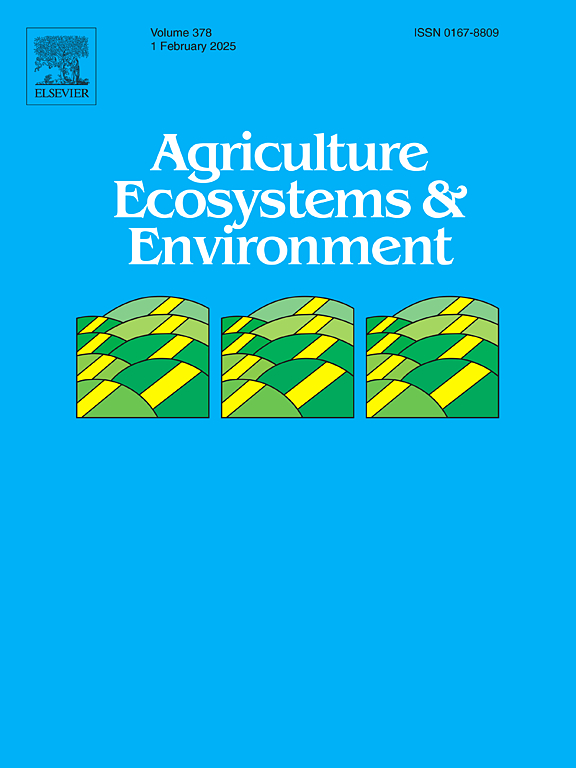Nitrous oxide emissions and emission factors in hairy vetch-maize sequences: The role of vetch termination timing on nitrogen synchronization
IF 6.4
1区 农林科学
Q1 AGRICULTURE, MULTIDISCIPLINARY
引用次数: 0
Abstract
Nitrous oxide (N₂O) emissions from agricultural soils represent a major environmental concern and require sustainable nitrogen (N) management strategies. The timing of hairy vetch (Vicia villosa Roth) termination was investigated to improve N synchronization and to assess its potential to replace fallow as an alternative N source for maize (Zea mays L.) without increasing N2O emissions compared to urea, while maintaining productivity. An experiment was conducted over two seasons to assess N2O emissions (43 measurements per season) and soil N dynamics in fallow/maize and vetch/maize sequences with two termination timings. Cumulative N₂O emissions in vetch/maize sequence ranged from 0.59 to 1.77 kg N₂O-N ha⁻¹ , while in fallow/maize ranged from 0.55 to 1.18 kg N₂O-N ha⁻¹ . Nitrogen fertilization increased emissions by 4.5–17.6 %, while the use of vetch before maize increased them by 9.6–48.5 % compared to fallow/maize sequence. Reducing the interval between vetch termination and maize sowing from ∼31 days (early termination) to ∼10 days (late termination) improved N synchronization by 13 %. Late vetch termination and N-fertilized fallow showed similar N₂O emissions, with improved synchronization reducing emissions by 13–21 % compared to early termination. Regression trees identified soil temperature, ammonium, and water-filled pore space (WFPS) as key drivers of N₂O emissions during the fallow or vetch period, whereas nitrate and WFPS became the dominant factors during the maize season. Furthermore, the first emission factors for hairy vetch (< 0.17 %) were reported, which were significantly lower than the IPCC default (1 %). These findings offer critical insights into refining greenhouse gas inventories and optimizing vetch management to reduce emissions while maintaining or enhancing maize productivity.
黄杨-玉米序列氧化亚氮排放及排放因子:黄杨终止时间对氮素同步的影响
农业土壤的一氧化二氮(N₂O)排放是一个主要的环境问题,需要可持续的氮(N)管理战略。研究了毛叶杨(Vicia villosa Roth)终止的时间,以改善氮素同步,并评估其作为玉米(Zea mays L.)替代休耕的潜力,而与尿素相比,不增加N2O排放,同时保持生产力。通过两个季节的试验,评估了休耕/玉米和野豌豆/玉米两个终止时间序列的N2O排放和土壤N动态(每个季节43次测量)。紫藤/玉米序列的累积N₂O排放量范围从0.59到1.77 kg N₂O-N ha⁻¹ ,而休耕地/玉米序列的累积N₂O-N ha⁻¹ 范围从0.55到1.18 kg N₂O-N ha⁻¹ 。与休耕/玉米顺序相比,施氮肥增加排放量4.5 ~ 17.6 %,先施用紫薇后施用玉米增加排放量9.6 ~ 48.5 %。将豇豆终止与玉米播种之间的间隔从早终止的~ 31天减少到晚终止的~ 10天,氮素同步率提高了13% %。晚播和施氮休耕表现出相似的N₂O排放量,与早播相比,改善同步可减少13 - 21% %的排放量。回归树发现,土壤温度、铵态氮和充水孔隙空间(WFPS)是休耕期或黄豆杉期氮素排放的主要驱动因素,而硝酸盐和WFPS在玉米季成为主导因素。此外,毛杨的第一发射因子(<;0.17 %),显著低于IPCC的默认值(1 %)。这些发现为完善温室气体清单和优化豇豆管理以减少排放,同时保持或提高玉米生产力提供了重要见解。
本文章由计算机程序翻译,如有差异,请以英文原文为准。
求助全文
约1分钟内获得全文
求助全文
来源期刊

Agriculture, Ecosystems & Environment
环境科学-环境科学
CiteScore
11.70
自引率
9.10%
发文量
392
审稿时长
26 days
期刊介绍:
Agriculture, Ecosystems and Environment publishes scientific articles dealing with the interface between agroecosystems and the natural environment, specifically how agriculture influences the environment and how changes in that environment impact agroecosystems. Preference is given to papers from experimental and observational research at the field, system or landscape level, from studies that enhance our understanding of processes using data-based biophysical modelling, and papers that bridge scientific disciplines and integrate knowledge. All papers should be placed in an international or wide comparative context.
 求助内容:
求助内容: 应助结果提醒方式:
应助结果提醒方式:


